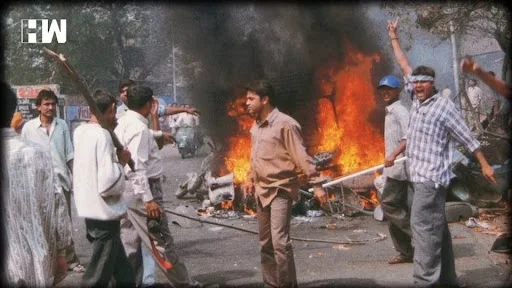Gujarat, a western state of India, has witnessed some of the worst communal riots in the country's history. Communal riots are violent clashes between different religious groups, often Hindus and Muslims, that result in deaths, injuries, and destruction of property. In this article, we will look at the causes, consequences, and aftermath of two major riots that occurred in Gujarat in 1969 and 2002.
## The 1969 Gujarat Riots
The 1969 Gujarat riots were the first major outbreak of communal violence in the state since its formation in 1960. The riots erupted in September 1969, after a minor dispute over a Hindu religious procession passing through a Muslim-dominated area in Ahmedabad, the largest city of Gujarat. The situation quickly escalated into large-scale violence that lasted for two months and spread to other parts of the state.
According to official figures, the 1969 riots claimed the lives of 660 people, injured 1,074 others, and displaced over 48,000 people. However, unofficial estimates put the death toll at over 2,000. Most of the victims were Muslims, who constituted about 9% of Gujarat's population at the time. The riots also resulted in widespread damage to mosques, temples, homes, and businesses.
The state government, led by the Indian National Congress party, was accused of failing to prevent or control the violence. The police and the army were also criticized for their delayed and inadequate response. The riots exposed the deep-rooted communal tensions and polarization in Gujarat's society and politics. They also triggered a rise of Hindu nationalist groups and parties, such as the Rashtriya Swayamsevak Sangh (RSS) and the Bharatiya Janata Party (BJP), which advocated for a Hindu-dominated state.
## The 2002 Gujarat Riots
The 2002 Gujarat riots were another horrific episode of communal violence that shook the state and the nation. The riots were triggered by a train fire that killed 58 Hindu pilgrims and activists returning from Ayodhya, a holy site for Hindus that is also claimed by Muslims. The train was set on fire by a Muslim mob near Godhra station on February 27, 2002. The incident sparked a wave of revenge attacks by Hindu mobs against Muslims across Gujarat.
The 2002 riots lasted for three days in February and March 2002, but sporadic violence continued for several months afterwards. According to official figures, the riots killed 1,044 people, injured 2,500 others, and displaced over 200,000 people. Of the dead, 790 were Muslims and 254 were Hindus. However, independent sources estimated that over 2,000 people may have been killed. The riots also involved brutal killings, rapes, kidnappings, and arson of mosques, homes, and businesses.
The state government, led by Narendra Modi of the BJP, who was then the chief minister of Gujarat and later became the prime minister of India, was accused of condoning or even encouraging the violence. The police and government officials were also alleged to have directed or aided the rioters and provided them with lists of Muslim-owned properties. Modi denied any role or responsibility in the riots and claimed that he did everything possible to restore peace and order.
The Supreme Court of India appointed a Special Investigation Team (SIT) to probe into the allegations against Modi and others. In 2012, the SIT cleared Modi of any complicity in the violence and said that there was not enough evidence to prosecute him. The SIT's report was challenged by some victims and activists who claimed that it had suppressed or ignored crucial evidence. However, in 2014, the Supreme Court upheld the SIT's findings and rejected any further petitions against Modi.
## The Quest for Justice
The Gujarat riots have left a lasting scar on the state's social fabric and communal harmony. They have also raised serious questions about the role of the state and its institutions in protecting its citizens from violence and ensuring justice for them. Despite several investigations, trials, and convictions over the years, many victims and survivors of the riots are still waiting for justice or compensation.
Some of the challenges faced by those seeking justice include delays in filing cases or chargesheets; lack of witnesses or evidence; intimidation or coercion of witnesses or victims; bias or corruption among judges or lawyers; political interference or influence; and lack of public awareness or support. Some of the initiatives taken to overcome these challenges include setting up special courts or tribunals; providing legal aid or counseling to victims or witnesses; conducting independent inquiries or fact-finding missions; mobilizing civil society groups or media outlets; and appealing to higher courts or international bodies.











